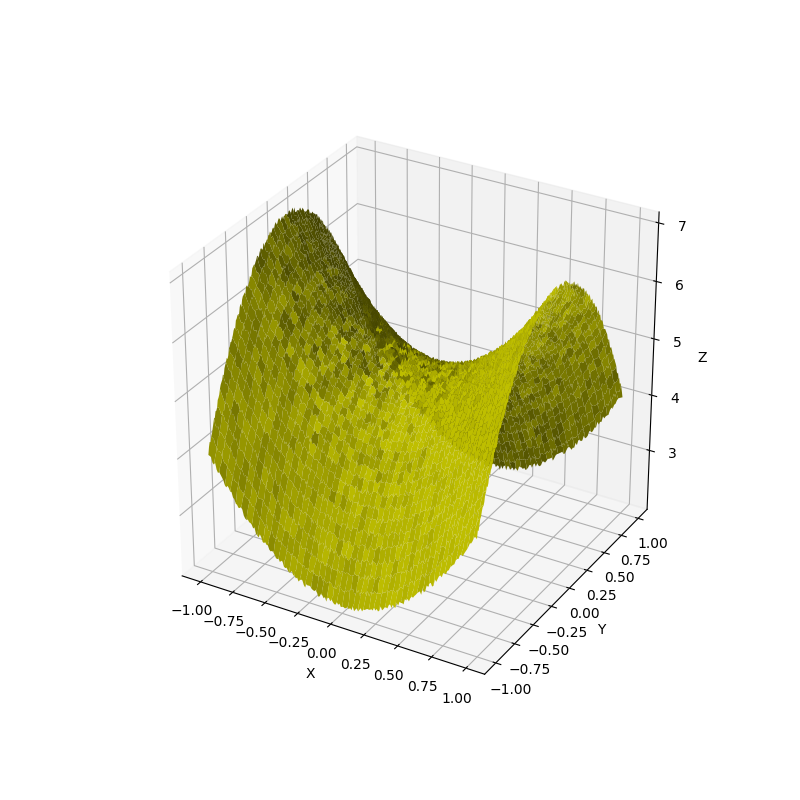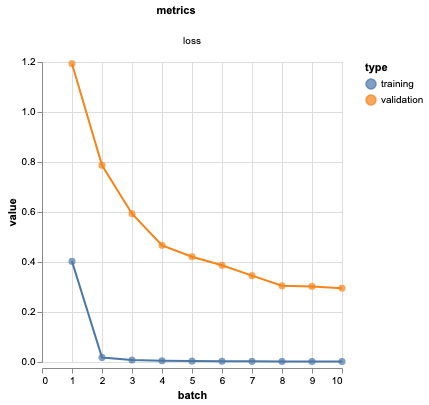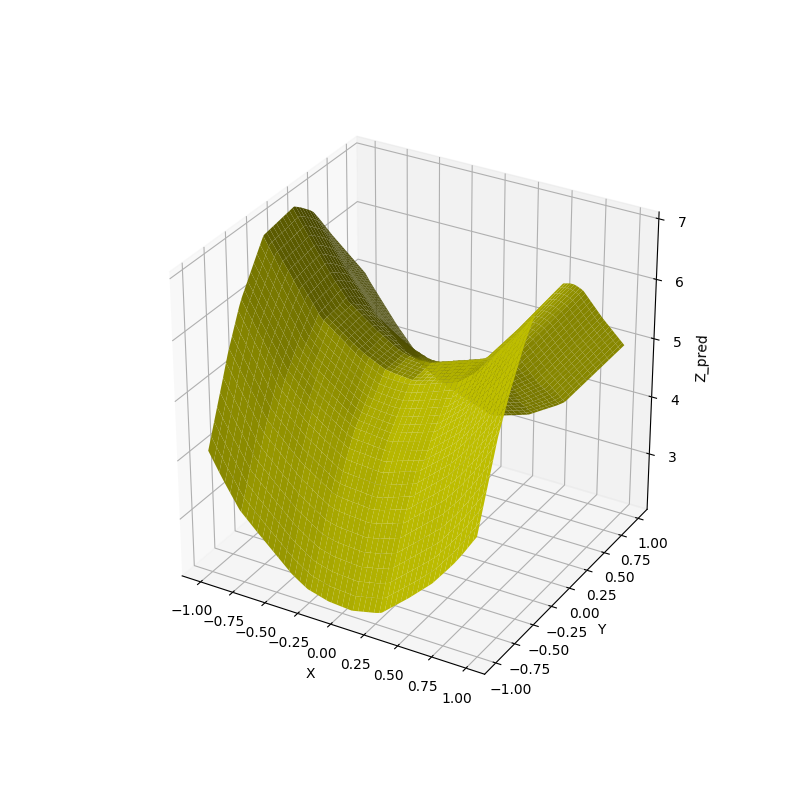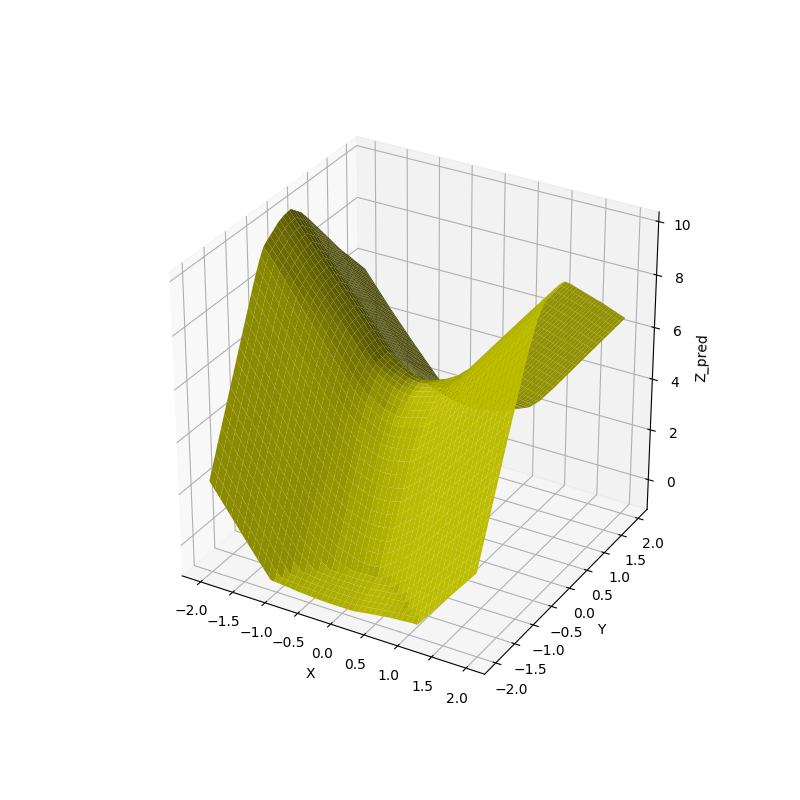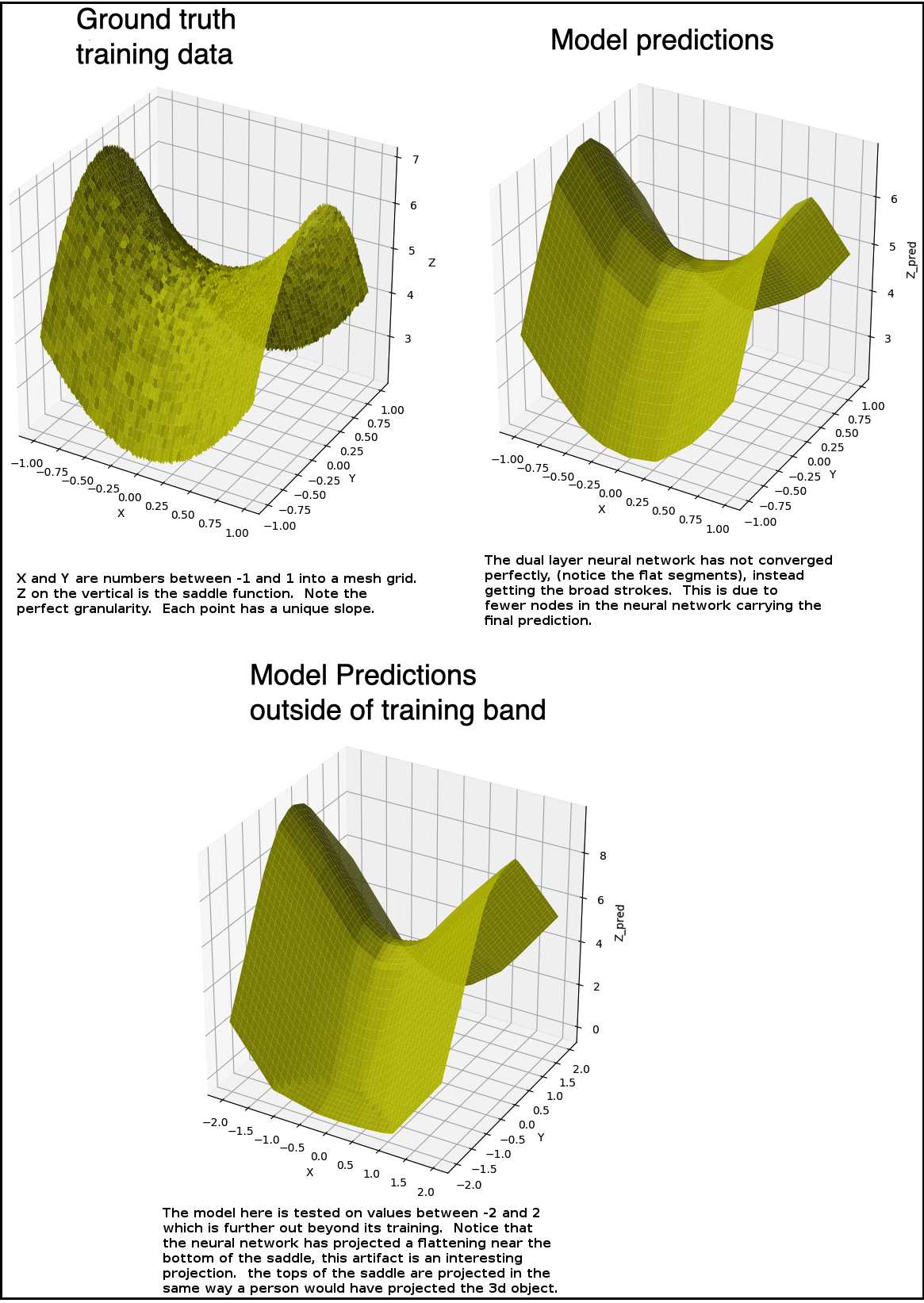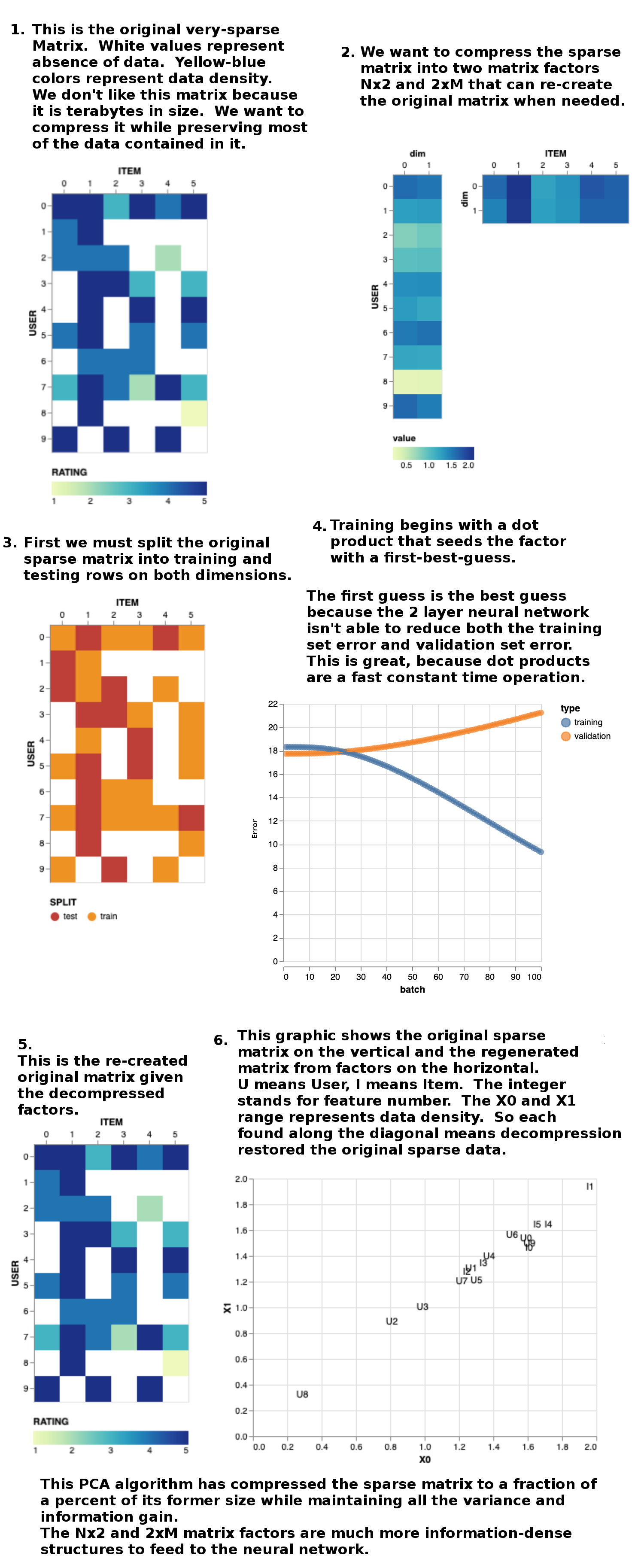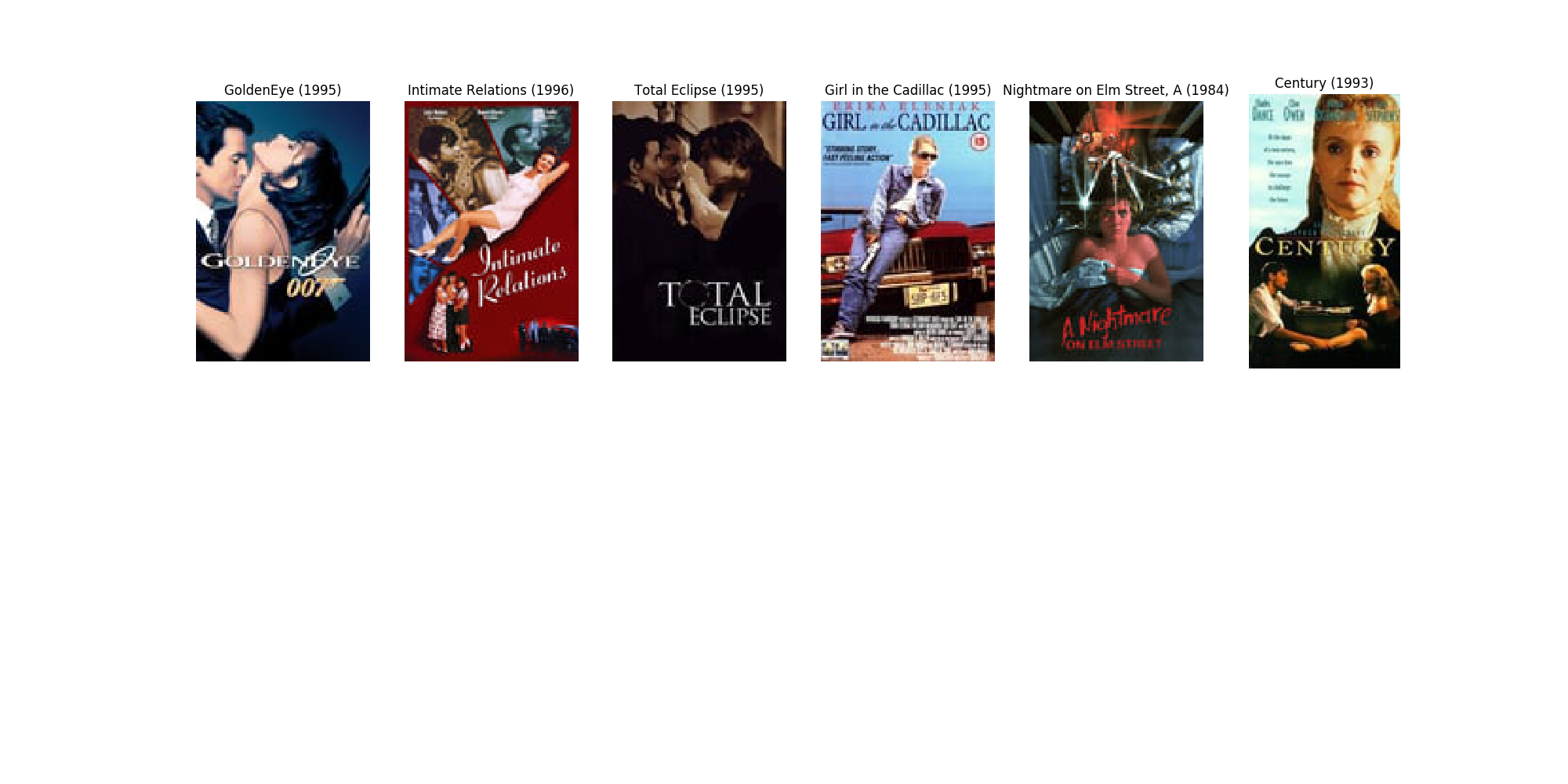2 Layer Neural network using keras and python for a recommendation engine.
To prove that our machine learning engine is working, Demo of learning a Noisy Saddle
Function => z=2*x*x-3*y*y+5+e
Dataset is MovieLens DataSet: https://grouplens.org/datasets/movielens
ratings.csv
users.csv
items.csv
#!/usr/bin/python
# -*- coding: utf-8 -*-
#Basics of Deep Learning
#Load Libraries
import numpy as np
import pandas as pd
#Load libraries for Visualisation.
import matplotlib.pyplot as plt
import altair as alt
#disable warnings for tensorflow, and add library tensorflow,
#tensorflow is still early-alpha-software and a big crybaby
import warnings
warnings.filterwarnings('ignore')
import tensorflow as tf
import recoflow
from recoflow.vis import Vis3d
warnings.resetwarnings()
#create some ranges of data for X and Y across 2 dimensions
x = np.arange(start = -1, stop = 1, step = 0.01)
y = np.arange(-1, 1, 0.01)
#Make a meshgrid that creates a 2d plane with it.
X, Y = np.meshgrid(x,y)
c = np.ones([200, 200])
e = np.random.rand(200, 200)*0.1
#lift the plane into the Z dimension to create a saddle 3d shape
Z = 2*X*X - 3*Y*Y + 5*c + e
#prepare and save the image
fig = plt.figure(figsize=(8,8))
ax = fig.add_subplot(111, projection='3d')
ax.plot_surface(X, Y, Z, color='y')
ax.set_xlabel('X')
ax.set_ylabel('Y')
ax.set_zlabel('Z')
#save out the image
plt.savefig('saddle.png')
X and Y are the input training, and Z is the prediction, the result of the Z saddle function.
#Using Deep Learning
#Step 0: Load Libraries
from keras.models import Model
from keras.layers import Dense, Input, Concatenate
#Step 1: Design the Learning Architecture, model definition
def deep_learning_model():
# Get the input
x_input = Input(shape=[1], name="X")
y_input = Input(shape=[1], name="Y")
# Concatenate the input
xy_input = Concatenate(name="Concat")([x_input, y_input])
# Create Transform functions
Dense_1 = Dense(32, activation="relu", name="Dense1")(xy_input)
Dense_2 = Dense(4, activation="relu", name="Dense2")(Dense_1)
# Create the Output
z_output = Dense(1, name="Z")(Dense_2)
# Create the Model
model = Model([x_input, y_input], z_output, name="Saddle")
# Compile the Model
model.compile(loss="mean_squared_error", optimizer="sgd")
return model
model = deep_learning_model()
model.summary()
#is this broke?
#from keras.utils import plot_model
#plot_model(model, show_layer_names=True, show_shapes=True)
#Step 2 learn the weights:
input_x = X.reshape(-1)
input_y = Y.reshape(-1)
output_z = Z.reshape(-1)
X.shape, Y.shape, Z.shape
input_x.shape, input_y.shape, output_z.shape
df = pd.DataFrame({"X": input_x, "Y": input_y, "Z": output_z})
df.head()
#fit the model
output = model.fit( [input_x, input_y], output_z, epochs=10,
validation_split=0.2, shuffle=True, verbose=1)
#Step 4: Evaluate Model Performance
from recoflow.vis import MetricsVis
df = pd.DataFrame(output.history)
df.reset_index()
df["batch"] = df.index + 1
df = df.melt("batch", var_name="name")
df["val"] = df.name.str.startswith("val")
df["type"] = df["val"]
df["metrics"] = df["val"]
df.loc[df.val == False, "type"] = "training"
df.loc[df.val == True, "type"] = "validation"
df.loc[df.val == False, "metrics"] = df.name
df.loc[df.val == True, "metrics"] = df.name.str.split("val_", expand=True)[1]
df = df.drop(["name", "val"], axis=1)
base = alt.Chart().encode(
x = "batch:Q",
y = "value:Q",
color = "type"
).properties(width = 300, height = 300)
layers = base.mark_circle(size = 50).encode(tooltip = ["batch", "value"]) + base.mark_line()
chart = layers.facet(column='metrics:N', data=df).resolve_scale(y='independent')
chart.save('eval_model_performance.png')
The algorithm splits the X and Y into training and testing sets and trains upon the training set and decreases the error between the predicted target and the correct target. The model learns the training data immediately, and slowly gets closer to perfection in the testing data.
#Step 5: Make a Prediction
Z_pred = model.predict([input_x, input_y]).reshape(200,200)
#prepare and save the image
fig = plt.figure(figsize=(8,8))
ax = fig.add_subplot(111, projection='3d')
ax.plot_surface(X, Y, Z_pred, color='y')
ax.set_xlabel('X')
ax.set_ylabel('Y')
ax.set_zlabel('Z_pred')
#save out the image
plt.savefig('saddle_learned.png')
The previous image shows that the dual layer neural network has correctly reproduced the prediction Z axis from every input X/Y. But if you can read the code, you would protest we could have achieved the same objective with a one to one hashmap! But to that we say hashmaps don't generalize, so lets show you how ours generalizes.
#Step 5b: Make a Prediction out of band, how are we looking?
#create some ranges of data for X and Y across 2 dimensions
x = np.arange(start = -2, stop = 2, step = 0.02)
y = np.arange(-2, 2, 0.02)
#Make a meshgrid that creates a 2d plane with it.
X, Y = np.meshgrid(x,y)
input_x = X.reshape(-1)
input_y = Y.reshape(-1)
Z_pred = model.predict([input_x, input_y]).reshape(200,200)
#prepare and save the image
fig = plt.figure(figsize=(8,8))
ax = fig.add_subplot(111, projection='3d')
ax.plot_surface(X, Y, Z_pred, color='y')
ax.set_xlabel('X')
ax.set_ylabel('Y')
ax.set_zlabel('Z_pred')
#save out the image
plt.savefig('saddle_learned_out_of_band.png')
Notice the X and Y axis has been increased out of the training band from -2 to 2, rather than just the training data -1 to 1. This provides some evidence that our model is correctly flinging the generalized projection area into visably pleasing directions.
The three side by side:
Day 1 Lesson 1 - doing PCA Principal Components Analysis via matrix factorization to maximize variance and minimize set size, for generalization.
#!/usr/bin/python
# -*- coding: utf-8 -*-
import warnings
warnings.filterwarnings('ignore')
#import recoflow
import numpy as np
import pandas as pd
from recoflow.preprocessing import EncodeUserItem, StratifiedSplit
import matplotlib.image as mpimg
import PIL
import matplotlib.pyplot as plt
warnings.resetwarnings()
ratings = pd.read_csv("ratings.csv")
users = pd.read_csv("users.csv")
items = pd.read_csv("items.csv")
# Encoding the data
interaction, n_users, n_items, user_encoder, item_encoder = EncodeUserItem(ratings,
"user_id",
"movie_id",
"rating",
"unix_timestamp")
train, test = StratifiedSplit(interaction, [0.8, 0.2])
train.shape, test.shape
#((80000, 7), (20000, 7))
min_rating = interaction.RATING.min()
max_rating = interaction.RATING.max()
min_rating, max_rating
#(1, 5)
# Model - Deep Factorisation
from keras.models import Model
from keras.layers import Embedding, Input, Dot, Add, Activation, Lambda, Concatenate, Dense, Flatten, Dropout
from keras.regularizers import l2
from keras.optimizers import Adam
def DeepMF(n_users, n_items, n_factors, min_rating, max_rating):
# Item Layer
item_input = Input(shape=[1], name='Item')
item_embedding = Embedding(n_items, n_factors, embeddings_regularizer=l2(1e-6),
embeddings_initializer="glorot_normal",
name='ItemEmbedding')(item_input)
item_vec = Flatten(name='FlattenItemE')(item_embedding)
# Item Bias
item_bias = Embedding(n_items, 1, embeddings_regularizer=l2(1e-6),
embeddings_initializer="glorot_normal",
name='ItemBias')(item_input)
item_bias_vec = Flatten(name='FlattenItemBiasE')(item_bias)
# User Layer
user_input = Input(shape=[1], name='User')
user_embedding = Embedding(n_users, n_factors, embeddings_regularizer=l2(1e-6),
embeddings_initializer="glorot_normal",
name='UserEmbedding')(user_input)
user_vec = Flatten(name='FlattenUserE')(user_embedding)
# User Bias
user_bias = Embedding(n_users, 1, embeddings_regularizer=l2(1e-6),
embeddings_initializer="glorot_normal",
name='UserBias')(user_input)
user_bias_vec = Flatten(name='FlattenUserBiasE')(user_bias)
# Concatenation of Item and User & then Add Bias
Concat = Concatenate(name="Concat")([item_vec, user_vec])
ConcatDrop = Dropout(0.5)(Concat)
# Use the Dense layer for non-linear interaction learning
Dense_1 = Dense(32, name="Dense1", activation="relu")(ConcatDrop)
Dense_1_Drop = Dropout(0.5)(Dense_1)
Dense_2 = Dense(1, name="Dense2")(Dense_1_Drop)
# Add the Bias
AddBias = Add(name="AddBias")([Dense_2, item_bias_vec, user_bias_vec])
# Scaling for each user
y = Activation('sigmoid')(AddBias)
rating_output = Lambda(lambda x: x * (max_rating - min_rating) + min_rating)(y)
# Model Creation
model = Model([user_input, item_input], rating_output, name="DeepFM")
# Compile Model
model.compile(loss='mean_squared_error', optimizer=Adam(lr=0.001))
return model
n_factors = 40
model = DeepMF(n_users, n_items, n_factors, min_rating, max_rating)
from keras.utils import plot_model
plot_model(model, show_layer_names=True, show_shapes=True, to_file='lesson4_model.png')
model.summary()
output = model.fit([train.USER, train.ITEM], train.RATING,
batch_size=32, epochs=5, verbose=1,
validation_data=([test.USER, test.ITEM], test.RATING))
from recoflow.vis import MetricsVis
MetricsVis(output.history)
from recoflow.recommend import GetPredictions
#%%time
predictions = GetPredictions(model, interaction)
#CPU times: user 33.2 s, sys: 4.01 s, total: 37.3 s
#Wall time: 23.7 s
predictions.shape
#(1586126, 3)
from recoflow.metrics import RatingMetrics
RatingMetrics(test, predictions)
from recoflow.recommend import ItemEmbedding, UserEmbedding
item_embedding = ItemEmbedding(model, "ItemEmbedding")
user_embedding = UserEmbedding(model, "UserEmbedding")
#Getting Recommendation
#Given an Item, what are the similiar items?
#Given a User, what items should I recommend?
from recoflow.recommend import GetSimilar, ShowSimilarItems
similar_items = GetSimilar(item_embedding, k=5, metric="euclidean")
similar_items
#ShowSimilarItems(1, similar_items, item_encoder, items, image_path='/tf/notebooks/data/data/posters/')
item_index = 1
item_similar_indices = similar_items
image_path='./posters/'
movie_title = items.iloc[0].title
s = item_similar_indices[item_index]
movie_ids = item_encoder.inverse_transform(s)
images = []
titles = []
for movie_id in movie_ids:
img_path = image_path + str(movie_id) + '.jpg'
images.append(mpimg.imread(img_path))
title = items[items.movie_id == movie_id].title.tolist()[0]
titles.append(title)
plt.figure(figsize=(20,10))
columns = 6
for i, image in enumerate(images):
plt.subplot(len(images) / columns + 1, columns, i + 1)
plt.axis('off')
plt.imshow(image)
plt.title(titles[i])
plt.savefig('lesson4_movie_titles.png')
from recoflow.recommend import GetRankingTopK
#Ranking Top K
#Get all the predictions for all users
#Remove all the items the user has already seen (train)
#Sort the remaining data by predicted ratings
#Cut-off at K
#%%time
ranking_topk = GetRankingTopK(model, interaction, train, k=5)
#CPU times: user 36.2 s, sys: 4.13 s, total: 40.3 s
#Wall time: 26.8 s
n_users * 5
#4715
ranking_topk.shape
#(4715, 4)
ranking_topk.head()
from recoflow.models import NeuralCollaborativeFiltering
ncf = NeuralCollaborativeFiltering(n_users, n_items, n_factors, min_rating, max_rating)
plot_model(ncf, show_layer_names=True, show_shapes=True)
Day 2 explicit and implicit feedback, how to handle a user's non-interaction with something as negative or neutral.
Explore these:
Image processing:
https://matplotlib.org/3.1.1/tutorials/introductory/images.html
Include the colorful images from here:
